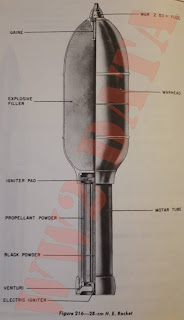German Explosives
38-cm H.E. Rocket, Spin Stabilized
Overall Length: 56.68 inches
Diameter: 14.94 inches
Total Weight: 761 pounds
Propellant Weight: 88.5 pounds
Type of Filling: 50/50 Amatol, poured.
Weight of Filling: 270 pounds
Description: The H.E. body is of two-piece welded construction and is threaded internally at the after end to receive the motor body. The booster pocket and fuze adapter is welded in position at the forward end.
The motor contains the propellant charge and igniters and is threaded internally to receive the venturi assembly. A relay igniter charge, consisting of three bags of gunpowder, is located in the perforation in the central propellant grain. The venturi assembly is drilled to form 32 jets at an angle of 14 degrees. In the center of the assembly is located a threaded hole for the electric squib. A rear spacer ring welded to the forward end of the venturi assembly acts as a grid and positions the outer row of propellant grains.
Remarks: The German designation for this round is "38 cm R. Sprgr. 4581"
The round is painted dark green overall, with an 0.8 inch white band painted around the center of gravity, and with black stenciling.
This round is notable among German rockets because of the steel splines inserted in the after end of the motor. These splines engage the rifling of the projector liner and aid in imparting an initial rotation to the projectile.
R 100 BS Air-to-Air Rocket
General Description: The R 100 BS air-to-air incendiary rocket was originally designed as an uncontrolled rocket for attacking bomber formations from fighter aircraft. This project was started in the latter part of July 1943. During the latter part of 1944, however, it was decided to use the Oberon Gerat to control the bursting point of the rocket, thereby improving the chance of a strike from a negligible value to a probability of about 0.4.
Details of the rocket are somewhat sketchy but the salient features seem to be that the total weight was 100 kg, 180 cm in length, with a maximum diameter of 210 mm. The propellant, consisting of 25 kg of normal rocket propellant, gave the projectile an impulse of 4,200 kg/sec with a burning time of 0.9 seconds. The maximum range was estimated at 2,000 meters and the maximum velocity of 550-600 m/sec.
The warhead weighed 30 kg and contained 460 incendiary cylinders filled with thermite, each weighing 55 grams. These cylinders were so arranged as to be stable during flight and fired forwards in a 60 degree cone. They were intended to ignite the aircraft petrol tanks and had a lethal range of about 18 meters. The incendiary cylinders had a velocity of 500 m/sec at ejection in addition to the velocity of the rocket.
Launching: Four of these projectiles were slung underneath the wings of a Me-262 and were launched electrically by rather complicated launching gear which comprised the following:
1. AZ 420 Kreiselvisir (Gyro Sight)
2. A radar range meter which is referred to as FUG 217 or 218.
3. A relative velocity meter known as the Oberon clock.
4. An Elfe, which apparently accepted signals from other components and carried out some sort of computation.
5. An altitude/angle computer.
6. A remote fuze setter.
It has been state that the rockets were launched electrically by means of the sight when the correct range (as measure automatically by the radar range-finder) was reached and not fired by the pilot. These four projectiles could be launched either singly or in salvo, for which purpose a ripple firing mechanism with a 0.1-second interval was incorporated. No control was applied after launching.
Remarks: Although this weapon had undergone satisfactory tests and was actually being produced, it never was, however, used operationally because of delays in the firing gear.
Next Time: Rockets (Part 20)
Source: German Explosive Ordnance Vol. 1: Bombs, Rockets, Grenades, Mines, Fuzes & Igniters










